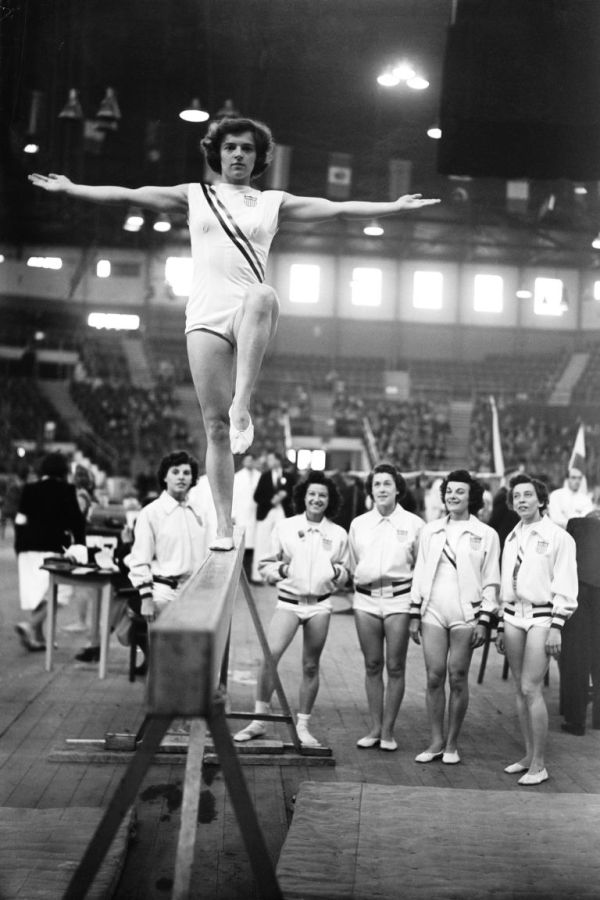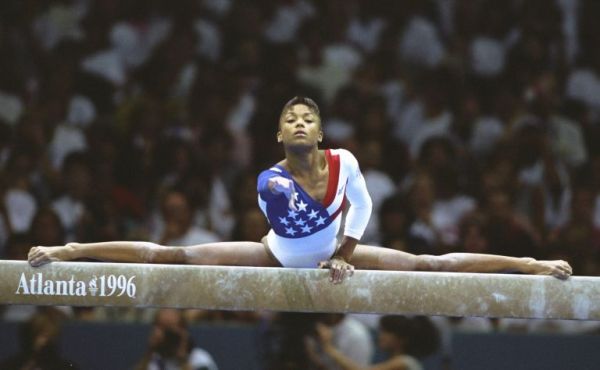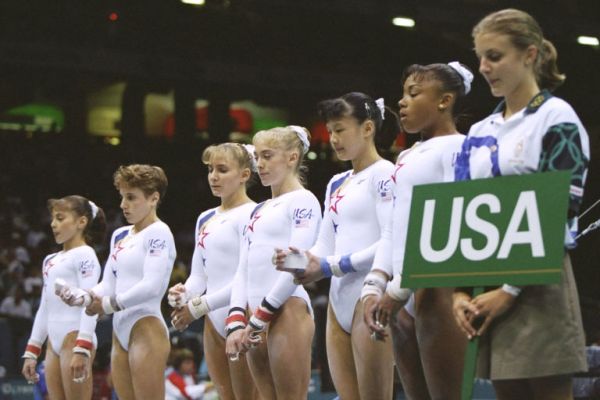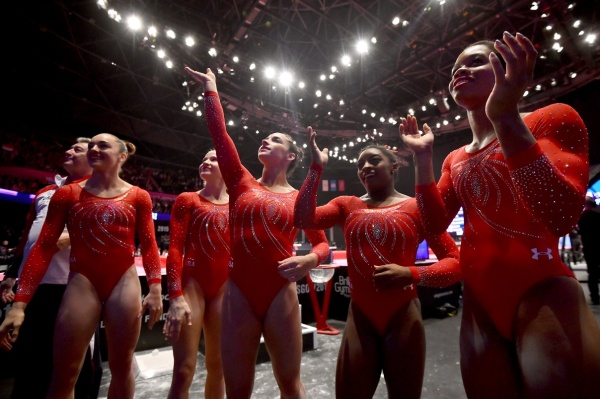 |
. The Gymternet is excited to bring you a guest post from Jennifer Kelly, a former acrobatic gymnast from Edmond, Oklahoma who now brings you the latest news, basics, and tips about gymnastics equipment such as mats and balance beams on her website Gymnasticslab. |
Gymnastics is one of the most fascinating sports to get addicted to, as athletics, science, and art are all rolled into one package. The performances we love are also enhanced by the leotards, which often are living, breathing organisms in themselves. We’re going to take you through the evolution of these leos adorned by the U.S. women, a history no less interesting than that of the sport itself.
The Beginning

Way back in the 1930s and 1940s, leotards looked a lot like beachwear, accommodating the modesty rules of the time. Low leg lines rules the roost for gymnastics of those early days where not much acrobatic adventure was expected.
This leo on Marine Barone at the London Olympics in 1948 showcases as an example.
As time progressed, the leotards changed their patterns, textures, and designs. Stretchy fabrics were introduced to increase flexibility and gymnasts’ muscular bodies were taken into consideration to make them as comfortable as possible.
Leotards first became more practical, but then eventually became more beautiful as well. By the 70s, the emphasis was on few colors and minimalist design, but by the time lycra was introduced in the 80s, the design became geared to fashionably portray patriotism with creative patterns.
The 1980s

Mary Lou Retton wore this pattern at the 1984 Olympics in Los Angeles when she performed her gold medal-winning routine.
Bold graphics on this star-spangled piece was just one aspect of leotards changing for the better. As you can see they also started going for higher cuts to create the optical illusion of longer legs.

With the infusion of newer technology, leos became more functional, and moreover, gymnasts’ physiques started to be accentuated, which you can see above done to amazing effect as Phoebe Mills’ ab muscles are perfectly shown at the Seoul Olympics in 1988.
The 1990s

While leotards began undergoing these changes in the 80s, the 90s took the patriotic fervor ahead with a big improvement in the elasticity of leotards with the help of advanced materials like velvet and mesh being incorporated into the design.
This bright white leotard at the 1996 Olympic Games in Atlanta proudly highlighted Dominique Dawes’ abs while the American flag was proudly emblazoned across the top.

The Magnificent Seven mostly stuck to pure white leotards to showcase their powerful bodies while also standing out with simplicity.
The 2000s

The most rapid changes came in the 2000s, where the creation of leos became a highly tech-oriented process. Function and aesthetics went hand-in-hand, which gave rise to some of the most beautiful leos in the history of U.S. gymnastics.
Fabric technology progressed by leaps and bounds to give increased durability. This has come to the rescue of gymnasts who have to perform almost impossible athletic feats. With the increased elasticity, the fabric has also taken on an increased shine, which makes it look like a second skin!
After the slowly advancing design tactics in the 80s and 90s, gymnasts began going for brighter colors and patterns in the next decade, including Nastia Liukin’s path-breaking hot pink leo at the 2008 Olympics in Beijing, a creation that included 184 hand-placed Swarovski crystals, automatically making it one of the top-ten leos ever for the U.S. team.
Leotards like these have become pieces of art, adding to the gymnast’s performance by serving a dual purpose — they make the gymnasts stand out in a crowd while also infusing in them a feel-good confidence that helps them give their best.

Taking Liukin’s leo a step further, Gabby Douglas went for a darker shade of pink at the 2012 Olympics in London, bejewelled by 1,188 Swarovski crystals, still recalled as one of the jazziest leos ever.
Today

The leotards in today’s generation are approached with an elaborate scientific process in place, putting stylistic distinction on par with ultimate functionality as the overall theme.
The specific physiques, skin color tones, body types, and even the color of the mats at various competitions are taken into account before final decisions are made. The traditional spandex leotard is layered with holograms and foil to create unparalleled durability and flexibility, while Swarovski crystals are being made lighter and placed on the leos in such a way that they don’t weigh the material down.

One of the most beautiful amalgamations of this science with art was this passionate red leotard on the U.S. women as they competed in the team final at the 2015 World Championships in Glasgow.

Finally, the glowing leotards worn by the women at the Olympic Games in Rio this past summer were the most lavish yet, each embellished by nearly 5000 crystals, making the girls sparkle in the arena as if they had light bulbs hidden inside!
This was made possible with the use of the best fabric for leos yet — mystique — along with the judicious use of bling to take the leotard evolution to the next level.
As sports technology sciences and design continue to evolve, leotards will continue to expand in their functional as well as aesthetic essence, and we can certainly look forward to adding some more phenomenal leos to our top ten list in the coming years.
What have some of your own favorite national team leos been? Share with us in the comments below!



I loved the 2016 Rio Floor Finals leo worn by Simone and Aly. Gorgeous!
LikeLiked by 1 person
Yes!!!
LikeLike
I always like the British leos. They always incorporate their flag in subtle interesting ways. I liked the ones in Rio that were white with the blue lion crest. Maybe that’s just my English ancestry talking.
LikeLike
I love Aliya Mustafina’s European Purple/ blue leotard. I love the color combination( being 2 of my favorite collors) I find it simple but elegant.
LikeLike
I still love white simplicity; Romanias 1987 worlds, Soviets 1972 Olympics, Romanias 1976 Olympics. These were truly classics that still look beautiful in both color and black and white photography.
LikeLike
My fave leos were 1) what the Russians wore in 1994 – the black velvet ones with a cutout on the upper chest. They wore them at the ’94 Goodwill Games and ’94 Worlds, I think. 2) is Lilia Podkopayeva’s ’96 Atlanta leotard – so classy with the deep green velvet and mesh arms.
LikeLike
I really like the 1940s one. They look sporty and strong. I hate having to look at a large swathe of every gymnast’s rear end these days. I find it so weird that the suits have become so high cut that it is now the norm to have a good part of the girl’s or woman’s butt not covered on purpose. It is enough to make me have second thoughts about letting a daughter do gymnastics.
LikeLike
My favorite US leo of all time has got to be the 2014 world team final one. So many modern US leos are way too over the top and flashy for me, but that one was just so regal and understated. I remember gasping the first time I saw it up close.
LikeLike
My favorite US leotard has to be the Alicia VT EF/Nastia UB EF/Shawn BB EF leo from Beijing. I loved the color combination and sporty design! The Mag 7 leo is a very close second.
The Brits probably have my favorite leos as a rule. I love how they are usually quite simple and incorporate the flag so nicely!
I also just love all of Ferrari’s strangely-sleeved leos.
LikeLike
I actually like the 1940’s one best, I think. I dislike the high cut styles they have to wear today. I guess I am old fashioned! I like simple but eye catching designs.
LikeLike
Anything but white! They always look so awkward, and as an adolescent so extra awkward.
LikeLike